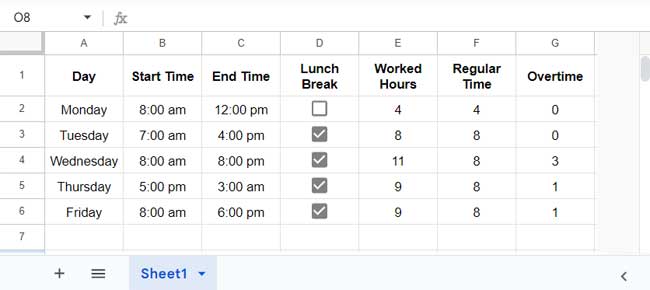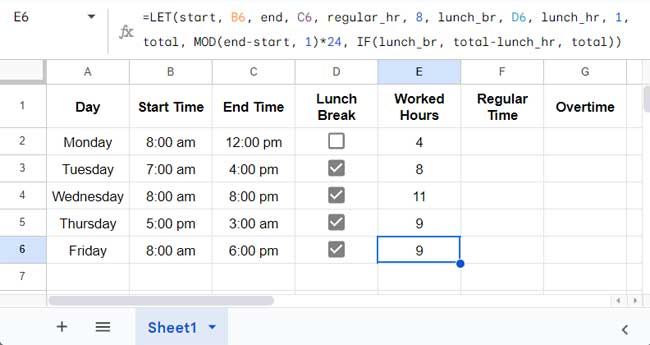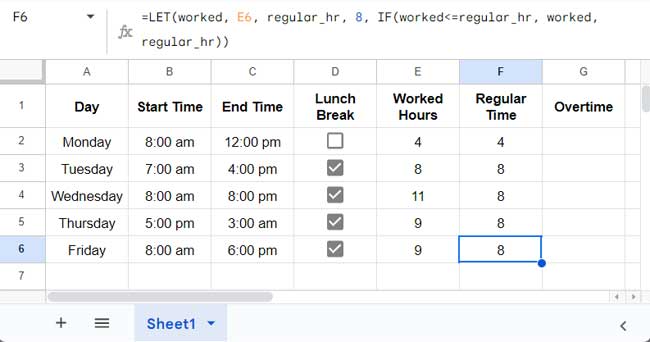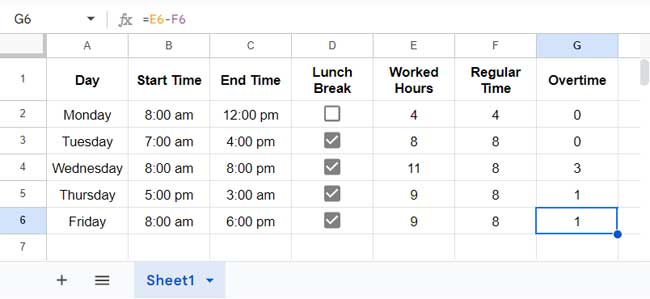With the help of flexible array formulas, you can automate overtime calculations in Google Sheets. However, you should use non-array (drag-down) formulas if you work on weekends and have a specific overtime rule for that.
The overtime calculation will be based on a daily threshold, such as 8 hours of regular time and 1 hour of lunchtime, with any hours worked beyond that threshold considered overtime.
You can customize the threshold value and lunch break hours. Additionally, you have the option to manually enable or disable lunch break subtraction, which is especially helpful for half-day work.

In this guide, you will learn one of the best overtime calculation formulas in Google Sheets. It’s flexible enough to meet your needs.
In our example, we have the start time in column B and the end time in column C. You can enable or disable the lunch break for specific employees by toggling the checkboxes in column D.
Let’s proceed with the step-by-step instructions.
Step 1: Streamline Worked Hours with a Formula
In cell E2, enter the following formula and drag the fill handle down as far as needed:
=LET(start, B2, end, C2, regular_hr, 8, lunch_br, D2, lunch_hr, 1, total, MOD(end-start, 1)*24, IF(lunch_br, total-lunch_hr, total))Then apply Format > Number > Number.

In this formula, the lunch hour is specified as 1 hour. If you have a different lunch break duration, such as 30 minutes, replace 1 with 0.5 (30/60).
Another change is the regular working hours, which is 8 hours in the formula. You should change that based on your regular working hours in a day.
Formula Breakdown
The above formula lays the groundwork for automating overtime calculation in Google Sheets. The other calculations are straightforward. Let’s delve into it in detail.
The formula follows the LET function syntax:
LET(name1, value_expression1, [name2, …], [value_expression2, …], formula_expression)It names value expressions and returns the result of the formula expression.
In the formula, start, end, regular_hr, lunch_br, and lunch_hr are self-explanatory. Regarding total, it is calculated as follows:
MOD(end-start, 1)*24 – calculates the worked hours.
Actually, (end-start)*24 would give the worked hours. However, it will provide a negative time difference if the end time spans past midnight.
MOD returns the remainder after dividing the time difference by 1. This ensures a positive time difference even if it spans past midnight.
For example, if the start time is 08:00 AM and the end time is 07:00 AM the next day, end-start would be -0.04 (if formatted as a number) and MOD(end-start, 1) would be 0.96 (if formatted as a number).
The time difference is the decimal portion representing the day, so we must multiply it by 24 to get the worked hours.
Here is the formula expression:
IF(lunch_br, total-lunch_hr, total)If the tick box in column D is checked (lunch_br is TRUE), the formula subtracts the specified lunch_hr from the total; otherwise, it returns the total.
This checkbox unchecking ensures that the lunch hour is not subtracted from the worked hours of a person who worked half a day.
Step 2: Define Regular Time with a Formula
In cell F2, insert the following formula and drag it down as far as you need:
=LET(worked, E2, regular_hr, 8, IF(worked<=regular_hr, worked, regular_hr))In this formula, you should replace 8 (regular_hr) with the stipulated regular working hours in your company. It should match the value (reular_hr) used in the formula in cell E2.

The IF function tests whether the worked hours are less than or equal to the regular working hours. If it evaluates to TRUE, it returns the worked hours; otherwise, it returns the regular hours.
Step 3: Automate Overtime Calculations
In cell G2, insert the following formula and drag it down:
=E2-F2
This formula will return the overtime hours by subtracting the regular hours from the total worked hours.
This method allows us to automate overtime calculations in Google Sheets.
Step 4: Handling Weekends and Holidays in Overtime Calculations
If you work on Saturday, Sunday, or any specific holiday, the overtime calculation may differ from the above. In such cases, all hours worked might be considered as overtime.
To accommodate this, you simply delete the regular time in column F from the corresponding rows.
That’s why I kept all the formulas as non-array formulas. If you don’t have entries for weekends and holidays, you can convert those three formulas into array formulas. Here they are:
=ArrayFormula(LET(start, B2:B6, end, C2:C6, regular_hr, 8, lunch_br, D2:D6, lunch_hr, 1, total, MOD(end-start, 1)*24, IF(lunch_br, total-lunch_hr, total))) // E2 formula
=ArrayFormula(LET(worked, E2:E6, regular_hr, 8, IF(worked<=regular_hr, worked, regular_hr))) // F2 formula
=ArrayFormula(E2:E6-F2:F6) // G2 formulaThis concludes the process of automating overtime calculation in Google Sheets.
Resources
Here are some Google Sheets resources specifically for start-time and end-time calculations.




















Hello,
I’m trying to create a formula for a timesheet. I would like to have an “hours worked” section. In that section, you can add any number. Anything over 40 hours, would be overtime.
Three Boxes: Hours Worked – # of regular hours worked – # of overtime hours worked.
I’m stumped to all heck. Any advice? Thanks
Hi, Kyle,
The formula may depend on many factors. I don’t know what values you have in your columns and in which format. So, if possible, please share a sample sheet URL in the reply. Show me your result also.
Hi,
Thanks so much for the quick reply! I’m sure it’s rather simple but I’m lost. Hope this link works.
— link removed from this thread by the admin —
Hi, Kyle Gregory Arnhart,
Thanks for the sample sheet.
I could see that cell C4 contains the total hours worked.
You want to split it into two parts, i.e., the regular hours worked in cell C5 and the overtime hours worked in cell C6.
You can use the below two IF statements.
In Cell C5:
=if(C4>40,40,C4)In Cell C6:
=if(C4>40,C4-40,0)I hope this helps?
How do I calculate total OT worked from total Hours worked… time going above 40 hours (total hours worked is in Column J6 in case anyone is looking to write the formula out).
Hi, Mika,
You can try the below combo formula.
=max(0,value(J6)-value("40:00:00"))If it’s (the formula is) in cell J7, format it to duration (Format > Number > Duration).
The formula is great, but why the mod function works here. What’s the catch, how it works exactly?
Hi, Domagoj,
See the output of the following formulas.
=mod(1,1)result 0
=mod(-0.99,1)result 0.01
The formulas return the remainders 0 and 0.01 respectively after dividing the number 1 in the first example with 1 and -0.99 in the second example with 1.
Now you may insert the below formula in cell H3 and copy to H4, H8, and H9 then format it to number (Format > Number > Number).
=C3-B3In the cell I3, insert the below formula and copy as above to I4, I8, and I9.
=mod(H3,1)Format these values also to number. You will understand how the formula works and why or how we can use the MOD formula as one of the best overtime (OT) calculation formula in spreadsheets.
You could just do it this way and change the multiplier if you needed to.
(i.e. for double time, put 2 instead of 1.5)
=IF('hours'40,40*'StdPay'+('hours'-40)*('StdPay')*1.5))))You’ll find that this could work in almost any scenario where you have at least the 2 necessary variables;
Hours and Standard Pay Rate.